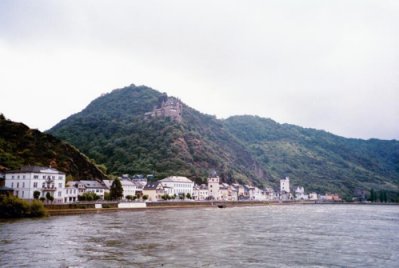 |
Rhine Revisited by Gregory E Bandlow
After the Counts of Katzeneinbogen had built Burg Rheinfels above St.
Goar in the middle of the 13th century, they then had Neukatzeneinbogen
Castle or "Burg Katz" for short, erected on the other side. Completed in
1371 it served to reinforce Rheinfels Castle and safeguarded the crossing
point to its training grounds, it also defended the little town of Hausen
and made it possible to give early warning of ships coming round the
Loreley. With its sister, it thus provided an effective barrier across
the river and above all it defended its right to levy custom duties on
Rhine River traffic. With steep walls of a rocky ledge, the castle
stands protected on three sides. On the side towards the hill, a deep
moat was constructed, hewn out of the stone. A stone bridge, which led
to a long bailey, could be blown up in times of war. This castle like
most of the other castles along the Rhine was blown up in 1806 by
Napoleon, but it was rebuilt around the turn of the century.

|
Burg Rheinfels on the St. Goar side of the Rhine was started in
1245 by Graf Dieter V von Katzeneinbogen. Only ten years later it was
able to stand its first test when attacked by 9000 soldiers of the Rhenish
Town Alliance because of an increase in custom duties on the Rhine.
After 40 unsuccessful charges and a siege that lasted more than a year, they
were forced to with drawn empty handed. The castle again saw action in the
Palatinate War of Succession. The castle again saw action in 1692. With
4000 defenders, it was the only fortress to with stand the assault of
the French army. The French tried for over a year to conquer the
fortress and used 28,000 troops and 56 pieces of artillery, but failed.
Neglected by 1794 it fell to the French without a fight. The weak
commander of the castle was later sentenced to death for this.
It is here at St. Goar and St. Goarshausen that our Rhine cruise ends.
We were to disembark on the St. Goarshausen side of the river, not
unlike the 89th Infantry Division who's bridge once graced this spot.
Today it is a crossing point for a car ferry and a stop for Rhine River
passenger boats. In 1945 it was the site of a floating bridge erected
as the crossing point for a division. As I reflect back on our journey,
I can't help but wonder how it was that I would be brought to the exact
spot of my father's crossing long before I knew him. It is a small world
indeed.
As we disembarked and headed back for our bus, I tried to explain to
my children the uncertainties that these young men faced in 1945.
Most were very young. I also attempted to convey the many acts of
courage these men displayed. I wonder if I could show the same courage
under similar circumstances. But, ultimately these men sacrificed for
us, every American. The price of freedom is never cheap and must be
defended time and again from tyrants. This generation went on to accomplish
just that. They defended our freedom, ended suffering for millions and created
a way of life, the life we now enjoy, and so often take for granted. This
generation changed the world. I don't know how much I told my children was
understood, but perhaps someday they will come to know these men as I have.
And maybe someday, they will understand why when I spoke of them, there was
a crack in my voice and a tear in my eye.
Previous
|
 |

